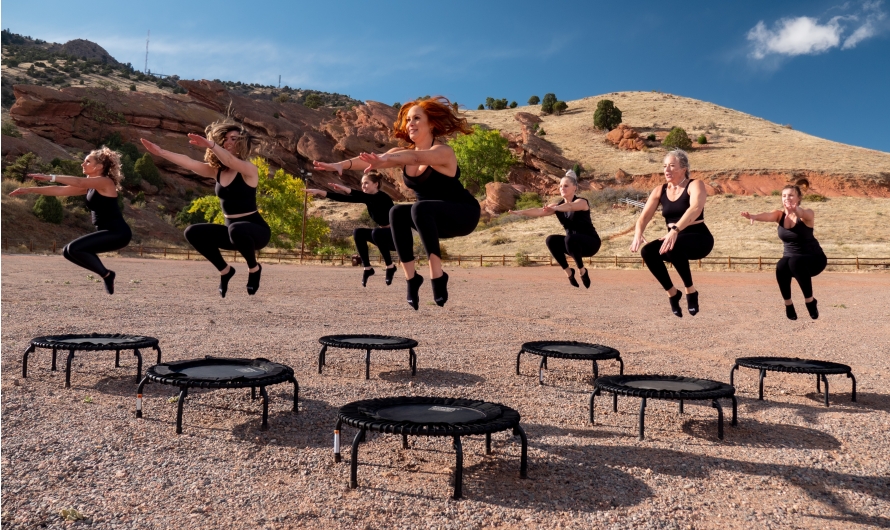Exercising on a trampoline at home offers many health and fitness benefits that can help you get in shape and feel great. Here are some of the top reasons to add trampoline workouts into your routine:
Improved Cardiovascular Health
Jumping on a trampoline provides an excellent cardio workout that can strengthen your heart, lungs, and circulatory system. The up and down motion increases your heart rate and improves blood flow throughout your body. Regular cardio workouts on a trampoline can help lower blood pressure, cholesterol levels, and the risk of heart disease.
Studies have found that rebounding on a trampoline significantly increases oxygen uptake and improves stamina more than running on flat ground. The variability of impact while bouncing challenges your cardiovascular system in new ways. Just 15-30 minutes of bouncing 3-4 days per week can lead to excellent cardiovascular conditioning.
Increased Muscle Tone and Strength
The constant stabilization required by bouncing on a trampoline engages all of your major muscle groups, especially your core and legs. This leads to increased muscle tone throughout your body. The acceleration and deceleration of your body weight during each bounce acts as resistance training to strengthen your muscles.
You’ll notice improved muscle definition in your legs, glutes, abs and arms after just a few weeks of regular trampoline workouts. Jumping uses your own body weight instead of external weights for resistance, protecting your joints from injury. It’s an extremely efficient way to gain lean muscle mass.
Weight Loss
The combination of a high calorie burn plus muscle building makes trampoline exercise an extremely effective tool for weight loss. A 150 pound person can expect to burn over 400 calories in just 30 minutes of moderate bouncing. The more vigorous and intense your workout, the more calories you’ll burn.
Unlike steady state cardio such as jogging, rebounding involves intermittent bursts of high intensity motion. This interval training forces your body to keep burning calories even after you stop exercising. By building metabolism-boosting muscle and burning fat, trampoline workouts will help you lose weight quickly.
Stress Relief
The joyful, bouncy motion of exercising on a trampoline is inherently stress-relieving. Focusing on coordinating your bouncing rhythm activates your cerebellum, shifting your mind into a meditative state. This can relieve anxiety, clear your head, and uplift your mood.
Releasing endorphins while bouncing encourages relaxation and improves sleep. The soothing rocking sensation and decreased stiffness after a trampoline workout can make your body feel more relaxed. Trampolining with music you love enhances the stress-relieving benefits.
Fun Way to Exercise
For many people, the tedium of repetitive exercises is the biggest barrier to working out consistently. Trampolining solves this problem by turning your workout into an exhilarating game! The playful experience triggers your inner child, making exercise enjoyable instead of a chore.
You can invent fun routines to keep yourself engaged during your trampoline workout. Try seeing how many spins, seat drops or crazy bounces you can link together. The variety of movements possible on a trampoline keep your body and mind active. Home trampolines are wonderful for getting the whole family exercising and playing together.
How to Choose the Right Home Trampoline
If you’re considering buying a trampoline for your backyard, there are several factors to take into account to ensure you select the right one. Safety, durability, size, shape and budget are all key considerations when choosing a home trampoline.
Consider Size and Weight Limit
Trampolines range in size from very small fitness trampolines just 3-4 feet wide to large rectangular or round models up to 16 feet across. Consider the space in your yard as well as the ages and sizes of people likely to use it.
The weight limit reflects the number of people who can safely jump at one time. Average weight limits are about 220 pounds for children’s trampolines and up to 450 pounds for heavy duty adult fitness trampolines.
Bigger trampolines allow more people to exercise together, but take up more room. Smaller fitness trampolines are very portable but made for individual use.
Safety Features
Safety is paramount when selecting a trampoline, especially if children will be using it. Key features that reduce injury risk include:
- Safety padding – Thick pad covering springs/frame
- Net enclosure – Mesh netting around edges
- Ladder – Allows safe mounting and dismounting
- Handlebar – Stabilizes entry for younger kids
The frame and bounce mat should be made of durable, UV-resistant materials. The legs need proper ground anchors to prevent tipping over in windy conditions.
Durability
Cheaper trampolines may deteriorate quickly from sun and weather exposure. Higher quality materials last longer and are safer. Key indicators of durability include:
- Weather-resistant frame – Galvanized rust-resistant steel
- Rust-resistant springs – Galvanized or stainless steel
- UV-blocking mat – Cross-sewn for strength
- Warranty – At least 2-5 years on frame/mat
Replacement parts should be readily available from the manufacturer for years beyond initial warranty.
Shape and Materials
Round or rectangular trampolines perform similarly, so shape depends on personal preference and yard space. Rectangular trampolines may feel more stable for beginners.
The bounce mat was traditionally made of web-like nylon or polypropylene. Permatron mats have greater bounce, while traditional mats have a softer feel. Premium options include springless fiberglass rods or steel springs with shock absorbers for joint protection.
Budget
Trampolines range from $100 for very basic kids’ models to over $2000 for high performance fitness trampolines with all features. Determine how much bounce and support you need, then get the highest quality trampoline you can afford. Consider it an investment in better health that will last for years.
Beginner Trampoline Workouts
Once you have a safe, durable trampoline properly set up, it’s time to start bouncing! Here are some great beginner routines to get you moving on your new home trampoline:
Basic Bouncing
Simply jogging lightly on the trampoline is enough to raise your heart rate and start building cardiovascular fitness. Focus on maintaining a smooth rhythm instead of jumping high. Land with soft knees to reduce impact on your joints. Work up to 5-10 minutes of gentle bouncing.
Jogging
Briskly walk or lightly jog in place, speeding up and slowing down. Pump your arms back and forth naturally as you build up a light sweat. Keep your movements controlled so you don’t lose balance. Aim for 1-2 minutes of jogging at a time.
Jump Squats
Stand with feet hip-width apart. Push off strongly to propel both feet off the mat as you raise your arms overhead. Land softly back in a squat position with knees bent. Repeat for 30 seconds up to 2 minutes at a time.
High Knees
Lift your knees as high as you can with each bounce, pumping arms back and forth. Maintain an upright posture. Work on coordination by trying to touch hands to opposite knee at top of each bounce. Do intervals of 20-30 high bounces.
Butt Kicks
Kick your heels straight back to touch your glutes while bouncing. Keep torso vertical and back flat. Land on balls of feet with knees slightly bent. Butt kicks challenge balance and burn calories. Do 10-20 focused butt kicks at a time.
Take breaks as needed between exercises. Stay hydrated and don’t overexert yourself while getting used to new motions. Aim to build up to 20 minutes of beginner bouncing routines.
Intermediate Trampoline Workouts
Once you’ve developed a basic fitness foundation on your rebounder, try incorporating these more advanced bouncing exercises:
Jump Lunges
From standing, lunge down into one leg, then powerfully switch legs while airborne. Land softly into a lunge on the opposite side. Work on control and stability before trying to jump higher. Do 10 reps per side.
Pike Jumps
Launch up, bringing knees to chest while keeping legs straight and torso upright. For more intensity, reach arms straight overhead as you pike legs up. Land gently and reset. Build up to 10-15 pike jumps in a set.
Tuck Jumps
Jump up, pulling knees to chest. Aim to make yourself “small” in the air by bringing torso forward and squeezing abs engaged. Avoid arching back. Explosively return to start in athletic stance. Repeat for 15-20 tuck jumps.
Straddle Jumps
Jump up while spreading legs wide into a straddle position. Keep torso upright as you fully extend legs. Land with control, knees bent to absorb impact. Build power in inner thighs with 10-20 reps.
Front and Side Leg Lifts
Lift one leg forward, to the side, or back while balancing on the opposite leg. Work on stability before bouncing higher. Keep standing leg slightly bent. Do 10 controlled lifts on each side.
Focus on proper form and alignment during intermediate drills. Stop immediately if you feel pain. Increase difficulty by doing combo moves like tuck jumps into straddle jumps.
Advanced Trampoline Workouts
With practice and conditioning, you can start learning impressive tricks on your trampoline at home. Always be very cautious when attempting advanced skills:
Suicide Jumps
Start seated near edge of trampoline with legs extended. Rock forward into a handstand, then push smoothly up to land on feet, controlling momentum as you sink down into a squat. Keep legs extended.
Front and Back Flips
Build confidence by starting flips on the ground first. Move onto trampoline and stay centered. Push off, tuck tightly into a ball and spot your landing to control rotation. Only attempt with proper training.
Seat Drops
Start seated at edge. Push off into a squat, shift hips back and quickly sit, extending legs for a controlled drop onto mat. Keep back straight and stand tall immediately. Absorb landing in your glutes and hamstrings.
Knee Drops
From standing, shift weight back like sitting into a chair and extend one leg forward. Drop down, touching knee of extended leg to trampoline while balancing. Stand up smoothly into athletic stance.
Twisting Moves
Carefully build up skills like a Half Twist where you rotate only your upper body 180 degrees before landing facing the opposite direction. Or try a Full Twist where you turn a complete 360 in the air for an exciting dismount.
Advanced skills carry serious risk if not properly mastered. Enroll in lessons, use spotters, or attach a training harness while building skills. Stop immediately if dizzy or in pain.
Safety Tips for Exercising on a Trampoline
While hugely fun and beneficial, trampolines do pose some safety concerns. Follow these precautions to ensure injury-free bouncing:
Use Safety Padding
Thick frame padding is essential for preventing injuries from hitting the frame or springs. Check pads regularly for tears or deterioration.
Don’t Allow More Than One Person
Overcrowding the mat greatly increases risk of falling off or colliding into each other. Only allow one jumper at a time. Enforce turns for group use.
Supervise Children
Actively watch younger kids to ensure proper behavior and technique. Teach games that avoid risky moves like flips. Prohibit horseplay or stunts without adult monitoring.
Inspect for Damage
Routinely check for worn ropes, damaged springs, holes, and loose parts. Discontinue use immediately if any defect is found until repaired.
Learn Proper Form
Maintain control and land properly bent knees to avoid injury. Keep jumps low until conditioned for higher bouncing. Never attempt flips without training.
Additional tips include removing jewelry/shoes, waiting 1-2 hours after eating before use, and placing clear of any structures or hazards. Prioritize fun and safety!
Conclusion
Adding a trampoline to your backyard makes getting in shape irresistibly fun for the whole family. Rebounding delivers an excellent full body workout that burns calories, strengthens muscles, and improves cardiovascular fitness. With basic safety precautions, trampolines provide a lifelong activity for improved health.
The joy and comfort of having an at-home trampoline encourages regular exercise. A few minutes of bouncing a day is enough to boost your mood and energy levels. Choose a high quality trampoline suited for your needs and yard space. Progress gradually from beginner to advanced skills under proper supervision. Let your inner child out and bounce your way to better health!
FAQs
Q: How long until I see results from trampoline exercise?
A: Many people report feeling increased energy, less pain, and better sleep after just a few sessions on a rebounder. You’ll begin building muscle and burning fat right away. Stay consistent with 3-4 workouts per week and you should see noticeable improvements in strength, cardio fitness, weight loss, and tone within 4-6 weeks.
Q: Is trampolining safe for seniors?
A: Yes, rebounding is a fantastic low-impact exercise for seniors. It improves balance, bone density, joint health, and cardiovascular fitness. Make sure to start slowly, use safety rails, focus on low bounces, and have a spotter present. Avoid flips or stunts that could lead to injury.
Q: How many calories does jumping on a trampoline burn?
A: An average 150 pound person can expect to burn about 10 calories per minute while lightly bouncing on a trampoline. More vigorous jumping and intensive intervals will burn over 15 calories per minute. So a 30 minute bouncing workout can burn 300-450+ calories.
Q: Can trampolining help build abs?
A: Absolutely! The constant stabilization required while bouncing engages all your core muscles. Adding specific moves like tuck jumps, pike jumps, and twists will greatly strengthen your abdominal muscles. Just be sure to maintain proper form.
Q: What age is best for a child to start on a trampoline?
A: Trampolines can be safely enjoyed by kids ages 3 and up, but always under direct adult supervision. Introduce basic bouncing and games around age 5-6. Wait until at least age 8 and with instruction before attempting flips or risky skills to prevent injury.




